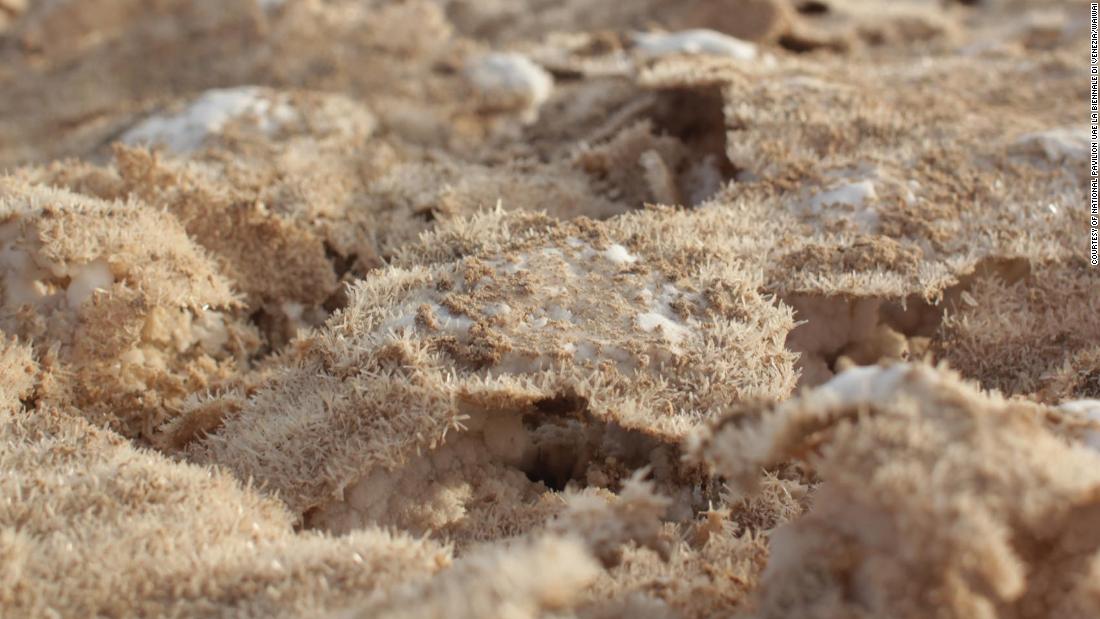
A Dubai-based architect duo is looking to break from conventional building practices with an alternative cement conceived in the salt flats of the UAE and made using a problematic waste material.
They were inspired by the UAE’s mineral-rich sabkha — salt flats that are part of the country’s wetlands. “It a huge area … that’s often overlooked,” Al Awar told CNN.
The ancient fortifications of Shali at the Siwa Oasis, Egypt. Credit: CRIS BOURONCLE/AFP/AFP via Getty Images
![A close up of a sabkha flat in the UAE. The flats contain microbes and are "a living environment [that] actually absorbs CO2," according to architect Wael Al Awar.](https://fpsgames.it/wp-content/uploads/2020/06/1593531574_980_UAE-architects-make-cement-out-of-salt.jpg)
A close up of a sabkha flat in the UAE. The flats contain microbes and are “a living environment [that] actually absorbs CO2,” according to architect Wael Al Awar. Credit: Courtesy of National Pavilion UAE La Biennale Di Venezia/waiwai
Brine contains magnesium minerals. Kemal Celik, an assistant professor of civil and urban engineering at New York University Abu Dhabi and part of a team at the university’s AMBER Lab, extracted a magnesium compound from the liquid, and used it to make the cement.
Celik says the cement was cast into blocks, which were then placed in a carbon dioxide chamber to set — an innovation which speeds up the production process. The cement was subjected to testing in the UAE before being sent to Japan, where blocks went through further strength and rigidity tests. In addition, an algorithm was developed to calculate how safe the blocks would be if used in construction, Mika Araki, a structural designer at the University of Tokyo, told CNN.
Precast blocks could be used to construct a single-story building “tomorrow,” says Al Awar, but he and Teramoto hope to develop the product further for use in multi-story buildings.
Al Awar claims their magnesium-based cement can “perform to the equivalent of Portland cement,” which uses calcium carbonate as a raw ingredient and is the most commonly used cement in concrete manufacture.
However, the magnesium cement has its limitations. As a salt-based product, it is liable to corrode steel reinforcement, he says, although reinforcement with other materials is possible.

Precast blocks of brine-based cement created by Al Awar, Teramoto and their academic collaborators. Credit: Courtesy National Pavilion UAE La Biennale di Venezia, photography by Sahil Abdul Latheef

Precast blocks are cured in a carbon dioxide chamber, as the cement requires a higher percentage of carbon dioxide to sufficiently harden than is contained in the atmosphere. Credit: Courtesy National Pavilion UAE La Biennale di Venezia, photography by Dina Al Khatib
Professor John Provis is deputy head of the Department of Materials Science and Engineering at the UK’s University of Sheffield, and is unaffiliated with the project. He says the salt-based cement is “a really good idea,” explaining globally only a third of cement is used in reinforced concrete.
“These brines are a pain to dispose,” he adds. “They’re taking a local waste and doing cool things with it. I think it’s a really nice synergy there.”
Al Awar says he and Teramoto are motivated by a desire to construct more sustainable and ecologically friendly architecture. “Given CO2 emissions in the world and global warming, and all these alarms that have been ringing for many years, it’s our duty — it’s our responsibility — to take action,” he says.

Kenichi Teramoto and Wael Al Awar, co-curators of the UAE National Pavilion at the Venice Biennale of Architecture. Credit: Courtesy National Pavilion UAE
In May 2023, Al Awar and Teramoto will curate the UAE National Pavilion at the Venice Biennale of Architecture, where the alternative cement will go on display in their “Wetland” exhibition. The pavilion will be made from magnesium-based cement, although Celik says the cement will not be brine-based because they are not yet ready to scale-up production.
“The research is still early,” says Al Awar. “It should go through the natural process of experiments and trial and error to get somewhere. But we are very optimistic.”

Malvagio fanatico dei social media. Pensatore hardcore. Pop cultureaholic. Organizzatore. Esperto di alcolici. Appassionato di cibo. Sostenitore di Twitter per tutta la vita






